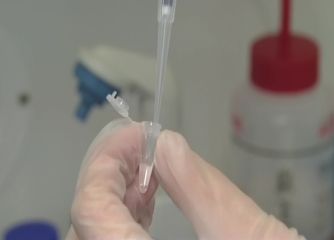Home > Press > Nanosized diamonds enable progress in retinal prostheses
 |
Abstract:
Research groups in several countries are making progress in retinal prosthesis development. If they achieve their aims, patients who have gone blind, due to loss of their photoreceptors, could recover a better simplified form of vision than with available prostheses. One of the groups shows that diamonds could lead the way.
Nanosized diamonds enable progress in retinal prostheses
EU | Posted on June 17th, 2011An artificial device in the form of a retinal prosthesis can replace dead photoreceptor cells by electrically stimulating the remaining neurons. Two examples of retinal prostheses are digital camera-type electrode arrays and photodiode arrays. However, they have exhibited low output of electric currents meaning external batteries are needed, low sensitivity and poor biocompatibility.
Researchers at Okayama University Graduate School of Medicine in Japan have tried to improve the performance of prostheses through the development of thin and soft photoelectric dye-based retinal prostheses, where the photoelectric dye chosen was not toxic to cells. By using a behavior test, they could see that the subretinal prototype implantation in rats led to recovery of vision. These prostheses absorb light and transform photon energy to produce electric potentials.
Scientists at the University of Tübingen in Germany have recently developed another subretinal prosthesis and tested it on patients. They have managed to show, for the first time, that micro-electrode arrays containing 1500 photodiodes can give previously blind patients a meaningful and detailed visual perception. Through a corresponding pattern of 38 x 40 pixels produced by the chip, one patients could for example read large letters as complete words, localize and approach persons freely and describe different sorts of fruit.
While another team of researchers from Moorfields Eye Hospital, Manchester Royal Eye Hospital, Quinze-Vingts, Second Sight, Retina Foundation Southwest and Johns Hopkins University, has shown for the first time that a large group of blind patients fitted with a retinal prosthesis can identify letters successfully. The patients used the Argus II Retinal Prosthesis System, but the researchers are working on the third model, increasing the number of electrodes from 60 to 240.
Researchers connected to the European Commission-funded project DREAMS are instead working on new types of nanotransducers, electric devices converting energy from one form to another, based on artificial nanocystalline diamond. The reasons for using diamond to coat the prosthesis are that this semiconductor show stability, biocompatibility and allow for reduced stimulation currents to improve the resolution from 60 pixels, where only shapes and colors can be seen, to 1000 pixels.
The scientists have tested the tiny prosthesis on retinal cells to see that it can replace the photoreceptors and U.S. colleagues have shown that a similar implant in humans can function. However, no clinical trials using the nanodiamond approach have been conducted.
Much more work is needed before any of these retinal prostheses can be widely available to patients, but the achievements made so far mean that thousands of people could be offered the possibility to recover an improved simplified form of vision in a not too distant future.
####
Contacts:
Elisabeth Schmid
Phone: + 39 02 700 25 72
Fax: + 39 02 700 25 40
Copyright © youris.com - EU research Media Center
If you have a comment, please Contact us.Issuers of news releases, not 7th Wave, Inc. or Nanotechnology Now, are solely responsible for the accuracy of the content.
| Related News Press |
News and information
![]() Researchers develop molecular qubits that communicate at telecom frequencies October 3rd, 2025
Researchers develop molecular qubits that communicate at telecom frequencies October 3rd, 2025
![]() Next-generation quantum communication October 3rd, 2025
Next-generation quantum communication October 3rd, 2025
![]() "Nanoreactor" cage uses visible light for catalytic and ultra-selective cross-cycloadditions October 3rd, 2025
"Nanoreactor" cage uses visible light for catalytic and ultra-selective cross-cycloadditions October 3rd, 2025
Possible Futures
![]() Spinel-type sulfide semiconductors to operate the next-generation LEDs and solar cells For solar-cell absorbers and green-LED source October 3rd, 2025
Spinel-type sulfide semiconductors to operate the next-generation LEDs and solar cells For solar-cell absorbers and green-LED source October 3rd, 2025
Academic/Education
![]() Rice University launches Rice Synthetic Biology Institute to improve lives January 12th, 2024
Rice University launches Rice Synthetic Biology Institute to improve lives January 12th, 2024
![]() Multi-institution, $4.6 million NSF grant to fund nanotechnology training September 9th, 2022
Multi-institution, $4.6 million NSF grant to fund nanotechnology training September 9th, 2022
Personal Care/Cosmetics
![]() DGIST and New Life Group launched a research project on "Functional beauty and health products using the latest nanotechnology" May 12th, 2023
DGIST and New Life Group launched a research project on "Functional beauty and health products using the latest nanotechnology" May 12th, 2023
![]() A Comprehensive Guide: The Future of Nanotechnology September 13th, 2018
A Comprehensive Guide: The Future of Nanotechnology September 13th, 2018
![]() Graphene finds new application as anti-static hair dye: New formula works as well as commercial permanent dyes without chemically altering hairs March 22nd, 2018
Graphene finds new application as anti-static hair dye: New formula works as well as commercial permanent dyes without chemically altering hairs March 22nd, 2018
![]() Programmable materials find strength in molecular repetition May 23rd, 2016
Programmable materials find strength in molecular repetition May 23rd, 2016
|
|
||
|
|
||
| The latest news from around the world, FREE | ||
|
|
||
|
|
||
| Premium Products | ||
|
|
||
|
Only the news you want to read!
Learn More |
||
|
|
||
|
Full-service, expert consulting
Learn More |
||
|
|
||








